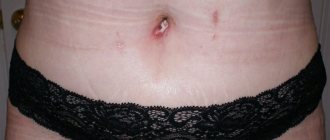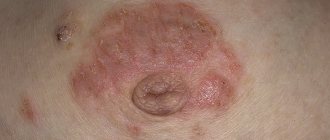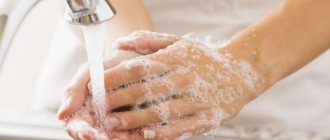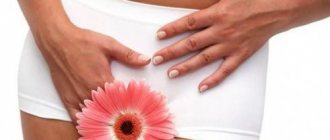- Pimples around the navel: causes
- Bacterial infection and acne on the navel
- Scabies and itchy pimples in the navel area
- Psoriasis and acne around the navel
- Allergies and acne below or near the navel
- Poor hygiene
- Pregnancy
- Pimple in the navel in an adult, treatment tips
Belly rashes and pimples around the navel area are most often caused by the development of infections and allergic skin reactions. But sometimes they can be caused by certain autoimmune diseases such as psoriasis. A rash around the navel should be treated properly through a prescribed course of treatment by a doctor to get rid of the infection or allergy. causing such a disease.
But you can also try some home remedies to get rid of this problem along with the treatment prescribed by your doctor.
In addition to the appearance of navel pimples, inflammation can be accompanied by other symptoms such as pain, itching, severe redness, etc. So, let's discuss all the problems and symptoms associated with navel pimples, their causes and treatments that can alleviate the problem and remove rashes located in this part of the abdomen.
Pimples around the navel: causes
There are many different causes of acne rash around the belly, ranging from mild allergies to hormonal disorders. Let's take a closer look at these causes of rash around the belly button.
Yeast infection on belly
Causes of yeast infection on the stomach:
The skin of the abdomen is more prone to excessive sweating when exerting itself, under the influence of synthetic clothing or in hot weather. This hot, humid and dark environment promotes the growth of yeast infections.
The yeast infection itself that causes the rash around the belly button is called a candida infection. It can also affect other areas such as the armpits, folds under the breasts, the mouth or oral cavity, and the vagina.
Symptoms of a yeast infection around the belly button:
Candida causes the development of red or pink rashes. These rashes are usually scaly and different from regular pimples. These red rashes may have yellow crusts on top of them.
Like many other fungi, this belly button candida infection is very itchy and painful at times. If you scratch or scratch the rash, it may bleed and may even have a foul odor from the rash.
Diagnostics:
A belly button rash caused by candida is identified through a physical examination by a dermatologist. But sometimes your doctor may take swabs from the belly button and send them for microscopic examination to make a more definitive diagnosis.
Treatment for yeast infection and pimples around the belly button:
A yeast infection on the belly button or candida fungus is treated with antifungal medications. Your dermatologist may prescribe you some antifungal creams such as clotrimazole for topical use and treatment of acne. If the infection is severe enough, your doctor may also suggest you take fluconazole tablets orally.
Salicylic-zinc paste for acne in the navel area!
Causes not related to diseases
One of the causes of a rash in the navel is insufficient hygiene.
The most common cause of a rash is poor personal hygiene. If the navel itches from the inside, this indicates insufficient care. It needs to be cleaned regularly; if this is not done, a rash may appear around the hole. It will be small, without pus and unbearable itching.
Dirt accumulates in larger volumes inside the navel than on the surface of the skin. After thoroughly cleaning the cavity and treating the rash with chlorhexidine, a person will get rid of unpleasant sensations in 2-3 days.
Sometimes girls with piercings develop a rash around the indicated area. This is also associated with an increased accumulation of bacteria in the puncture area and below, in the opening of the umbilical cord.
Nervous disorders as a cause
For some people, itchy sensations develop during periods of severe stress and emotional tension. Women are especially susceptible to the condition. Stress can change the hormonal balance, which often causes itching.
Prickly heat
The most common cause of rash in newborn babies. Miliaria occurs when thermoregulation is unbalanced. This condition is often found in children, but is not dangerous and does not cause discomfort and goes away quickly. The main symptom is small transparent pimples located next to the folds.
Contact dermatitis
This disorder is associated with wearing synthetic clothing, as well as excessive pressure (belt, belt). Pathology manifests itself as small spots and bubbles.
People who are overweight develop folds on their abdomen. Contact dermatitis can develop as large red patches around the belly button. The danger of contact dermatitis is the risk of infection and the addition of a fungal infection.
Itching and rash during pregnancy
During the period of bearing a child, a woman faces enormous changes in her body. In the 2nd trimester, the belly begins to greatly increase in size and the skin stretches. Local immunity temporarily deteriorates, which can lead to the formation of a rash. Sometimes women have an itchy navel without the appearance of red spots and pimples. This is a natural condition that does not require correction.
If a rash, unbearable itching, signs of inflammation, or suppuration appear, you should consult a doctor. This may be due to infection.
Abdominal injuries
Skin injury occurs when applying a tattoo or piercing. The skin is exposed to aggressive action and, if treated poorly, is susceptible to infection. Other injuries are also possible, for example, severe damage to the skin with sharp objects.
Bacterial infection and acne on the navel
Poll: When did your acne appear? (Number of votes: 4295)
I've been suffering all my life
It's been a couple of years now
About a few months
Recently
To vote, click on the desired answer. results
Causes of bacterial navel infection
The belly button area is susceptible to many types of infections, including fungal and bacterial infections. If you have wounds on your belly button due to cuts, surgeries such as laparoscopy, or belly button piercings, you are prone to developing a bacterial belly button infection.
If you have a belly button yeast infection with candida and you scratch a lot, this will create open sores that will develop secondary bacterial infections. If you touch your belly button with infected or dirty hands or expose your skin to the contact of a dirty T-shirt or shirt, this will further worsen your belly button. problem The most common bacteria that cause infections in the navel area are staphylococcus and streptococcus bacteria.
Symptoms
They will cause symptoms such as redness or red bumps and a red rash across the abdomen. These rashes will also be itchy, similar to a yeast infection. In severe cases, the rash on the abdomen tends to be painful and produces a foul odor that appears yellow or green. If the infection is severe and can lead to complications such as an abscess or even sepsis.
Diagnostics
Diagnosis of umbilical cord infection is mainly done by your doctor by examining the rash around the belly button, but sometimes he may need to send you for certain tests to decide whether antibiotics are needed to treat such bacteria.
Treatment
Your doctor will prescribe antibiotics to treat an infection caused by bacteria around your belly button. If the infection is severe, you will need to take oral antibiotics. If the infection is more severe, it may even need to be treated with intravenous antibiotics.
Causes of acne on the stomach in men
In men, rashes on the abdomen appear in most cases for the same reasons as in women. Unless in adolescence, acne can be a consequence of hormonal instability.
The most common causes of acne in men:
- Insufficient attention to personal hygiene. Dirt clogs the pores of the skin, which causes acne.
- Abundance of hair. Hair follicles can become inflamed and then painful, purulent rashes appear.
- Irritation from chafing trouser belt. Appears as small red pimples.
- In men who are seriously involved in weightlifting and bodybuilding, acne can be a consequence of taking anabolic steroids and consuming sports nutrition.
Scabies and itchy pimples in the navel area
Causes of scabies
Scabies is caused by a certain type of mite that burrows into the skin and lays eggs. They are highly contagious and spread from one person to another by touching or using contaminated clothing such as towels, etc.
Symptoms of scabies
Itchy pimples develop red rashes or bumps on the skin, mainly on areas such as the wrists, arms, ankles, buttocks, waist or navel, armpits, etc. These red bumps tend to itch for quite a long time.
Diagnostics
Scabies is diagnosed by your doctor through a physical examination. The doctor may also take a sample of skin tissue from the area of the rash to confirm the presence of mites.
Treatment
Scabies needs to be treated extensively to prevent the infection from spreading. It can be treated with many anti-scabies lotions and soaps that contain ingredients like permethrin, benzyl benzoate, lindane, sulfur, etc.
Symptoms of an allergic rash on the stomach in an adult and a child
In order not to confuse an allergy with an infectious disease, it is important to know its main symptoms. These include the following:
- With allergies, red or pink rashes appear on the stomach (sides). They can be either small and appear as nodules and papules, or they can look like large spots that slightly rise above the skin.
- With allergies, the stomach itches, the patient complains of severe itching and burning.
- The skin around the rash is swollen. Swelling may be present in other areas of the body (around the lips, on the cheeks, on the eyelids).
- A local increase in temperature is possible.
- Depending on the type of rash, the rash can be either dry or weeping.
Psoriasis and acne around the navel
Causes
The exact cause of psoriasis is not yet known, but many factors believed to cause psoriasis include genetics, autoimmunity, infections, side effects of antibiotic medications, and skin trauma.
Symptoms
Psoriasis is a skin disease in which skin cells divide at a rate much faster than normal skin cells. The newly divided cells enter the top layer of the skin, forming red patches covered with silvery scales.
They can affect any part of the body, including the navel, scalp, torso, arms, legs, etc. Also, these red spots and pimples are quite itchy and itchy.
Diagnostics
Psoriasis can be easily identified by your doctor due to the presence of silvery-white scales over red patches. These scratches also tend to bleed when scratched. Doctors can identify psoriasis through some other sophisticated tests and tests, if necessary.
Treatment
Psoriasis rashes that cause pimples near the belly button are treated using many types of topical creams or ointments that contain salicylic acid, coal tar, steroids, or calcipotriene. You may also be prescribed retinoids to treat this condition.
Methods for diagnosing the patient's condition
It is impossible to identify the exact cause of the violation without conducting a full examination. The patient needs to see a dermatologist and then undergo tests:
- general blood and urine examination;
- blood chemistry;
- scraping the skin in the affected area;
- allergy tests.
If, based on the test results, the doctor suspects diseases of the internal organs, he will prescribe an ultrasound, x-ray and other tests. In most cases, additional consultation with an allergist, infectious disease specialist, gastroenterologist and endocrinologist is required.
Allergies and acne below or near the navel
Many types of allergies can lead to a rash on your abdomen below or near your belly button. You may be allergic to new clothes made of non-breathable synthetic fabric, a new soap or detergent that was used to wash your clothes, or even because of a belly button piercing, etc. .
Belly button pimples and rashes like these should be treated by your healthcare provider. You need to take antihistamines. If the rash is severe, you may even need antihistamine injections to completely cure the allergy.
Range of additional causes of itchy rash
People often develop rashes in response to eating foods to which the person is allergic. The pathology manifests itself as urticaria - itchy blisters and spots.
Another pathology that is accompanied by similar symptoms is omphalitis. It is formed mainly in newborns and is associated with infection of the umbilical wound:
- redness covers the surrounding tissues;
- intoxication develops;
- pus and mucus are released from the wound;
- the navel protrudes, swelling appears;
- skin temperature rises.
Inflammation can penetrate deep into the organs if left untreated.
Pregnancy
Pregnancy is a wonderful time in a woman's life But it also comes with many changes in a woman's body that can cause discomfort and even acne in the belly button or face. During pregnancy, the abdomen expands, which causes the skin over the abdomen to stretch.
This causes the belly button or belly to become very itchy. If a pregnant woman scratches or constantly scratches the area, sores develop, leading to the growth of bacteria and fungi that cause a rash on the belly.
To avoid this problem, pregnant women should avoid dry belly at all costs. Try to moisturize your belly with a good moisturizer to avoid developing this rash around your belly button.
Erythromycin antibiotic ointment for acne!
rash around baby's belly button
Organization of a children's room
Some parents prefer to put their baby to bed for the first months of his life in his bedroom - either in a crib, or in a cradle, or in his own bed. Others believe that the child should live in the nursery from birth. Let’s not argue who is right: there are so many people, so many opinions, each family chooses what is suitable for it personally. But one way or another, the room in which the newborn baby is located must meet certain requirements.
First of all, the air temperature in winter should not fall below 21-22 degrees, and in summer it should not exceed 27-28 degrees. The second important condition is this: even if the climate in the room is maintained by air conditioning, it must be ventilated frequently to keep the air fresh.
If space allows, it is advisable to place a cabinet or table in the room for changing the baby: then mom and dad will have less back pain when changing the baby. Otherwise, changing diapers will have to be done on the wide parental bed (but not on the sofa in the living room, since there is not enough space there and the baby is more likely to roll onto the floor).
In principle, up to 3 months the baby will be more comfortable in a cradle or a removable cradle from a stroller. Cradles are available for rent at many baby goods stores, where parents purchase a trousseau for the baby. When choosing a permanent crib, be sure to check that it meets Israeli safety standards, considered one of the strictest in the world. It is better to install the crib near the inner wall of the house. If you have to place it against an external wall, make sure that the distance between the wall and the crib is at least 20 cm. A fleecy rug on the wall is undesirable, as it is an excellent dust collector, and therefore a potential source of allergens and microbes.
Check that the mattress on the crib fits snugly against its sides on all sides. And don’t forget to raise the side of the bed, even if your baby still seems completely helpless. Early development specialists advise placing bright pictures in the crib, at a distance of about 30 cm from the newborn’s eyes. But you don’t need to put a pillow or a folded diaper on the baby yet - support for his head will only interfere, not to mention the threat of suffocation. In winter, your baby will need a warm blanket or envelope. In summer, a light sheet or thin diaper is enough.
A little advice: some babies sleep better swaddled the old fashioned way, because sometimes the baby wakes himself up with chaotic hand movements in his sleep.
Daily baby care
Feeding
Without going into details of the choice (breastfeeding or formula feeding), we will consider only some general issues of feeding a newborn. Many parents are confused when they are told that the best indicator of whether the baby is getting enough food is a calm and contented child. Not every baby behaves calmly, even when he is completely full. He may be bothered by abdominal pain, discomfort and much, much more. Therefore, you should focus on the number of soiled diapers: a normally nourished child soils diapers at least 5-6 times a day. The above applies to babies born after the 37th week of pregnancy weighing more than three kilograms. For premature or very young babies, the indicators are different and you should consult a specialist about them.
Contrary to popular belief, breastfed babies do not need extra fluids. Mother's milk is already 90% water. But if the baby wets diapers less than 5 times a day, and his urine is dark and has a strong odor, you should offer him water (up to 50 ml per day) in between feedings. It is still advisable not to give water to a child until two months of age. But the most important thing is that no matter how much you want to give your baby something to drink, do not be tempted to add a little sugar, juice or syrup to the water. Before you know it, your smart child will become addicted to sweetened drinks. And this is harmful both to the child’s health and appetite. If you want to give your child herbal tea, make sure first that its composition does not include sugar of any kind - fruit, grape, and so on.
What young parents are most concerned about is usually weight gain: the better the child gains weight, the better (in their opinion) they cope with their responsibilities. On average, it is expected that in the first two weeks the baby should regain the weight with which it was born. After this, the minimum weight gain is 120 g per week. Some manage to gain weight by one and a half kilograms per month, others barely gain 500 g - both are within normal limits. After three months, the rate of weight gain will decrease slightly. In addition, babies fed breast milk are usually slimmer than those fed formula. The norms in the Tipat Halav consultation are designed for artificial people, and therefore are not the ultimate truth. In principle, by six months the baby should double its birth weight, and by one year it should triple it. It is clear that if a child was born weighing 3 kg, at six months or a year he will weigh much less than his peer who was born weighing 3.8 kg.
Some children lose weight not only by the time they are discharged from the hospital, but throughout the entire first month of life. This has nothing to do with the quantity and quality of mother's milk, so you should not refuse feeding if by one month your baby weighs the same as at birth. This phenomenon is explained by the severe stress that the most sensitive babies endure during childbirth.
A little tip: the long bolster, also called a nursing pillow, is very comfortable for both breastfeeding and bottle feeding. But it also has another purpose: you can use it to create a cozy nest around your baby. Experience shows that small children love to lie in a donut made from such a pillow.
Bottles and pacifiers
Long before giving birth, when choosing a dowry for the future baby, mom and dad buy both pacifiers and bottles, just in case. This is a reasonable step: at least one or two bottles can do a good job during breastfeeding, and a pacifier can sometimes soothe a crying baby (although recently more and more children are refusing this comforter, and parents do not insist, as was customary in the past). previous years). If your lifestyle involves a lot of bottle use, you might want to consider investing in a microwave sterilizer. For the first 3 months of a child’s life, bottles need to be sterilized at least once a day. The rest of the time, it is enough to wash them with soap and water and rinse with boiling water. But for serious sterilization, you will need either a microwave steam sterilizer or a large saucepan in which you can fill all existing bottles with cold water with lemon juice or a quarter of a whole lemon (to avoid limescale deposits on clean bottles). After bringing the water to a boil, boil the bottles for 3-5 minutes. A very convenient dryer is a stand with sticks on which clean bottles are placed. When purchasing pacifiers, choose ones that can be sterilized along with bottles.
Swaddling and changing clothes
The golden rule of swaddling sounds like this: diapers are changed either half an hour before meals, or during a feeding break, when the baby is weaned from the breast (bottle) so that he burps excess air. It is better to wash your baby every time under running warm water from the tap, rather than using sanitary napkins that are intended for walking and being outside the home. You do not need to apply baby cream every time, but only if the baby has been lying in a soiled diaper for a long time and redness appears on the skin. If, when using the cream, the redness does not go away within two days, consult a doctor: it may be a fungal infection of the skin and you need to resort to a special ointment. Sometimes redness appears with one type of diaper and is absent with another type. This can only be verified experimentally; the price and shape of disposable diapers do not play a special role. Whenever possible, allow your newborn to lie without diapers - this will benefit his skin.
Dressing a newborn, especially in the first weeks of life, should be done very carefully: babies easily overheat or become hypothermic. In addition, a wide-awake baby needs freedom of movement and, of course, you don't want your baby's clothing to rub or get in the way. Therefore, the most important thing is to choose the right children's wardrobe - only natural fabrics, comfortable (especially for you!) fasteners and functionality. In summer it is better to avoid multi-layered clothing, in winter - on the contrary, the more layers the baby wears, the warmer he is. For the first 1-2 months, a newborn can (but not necessarily if the air temperature is above 20 degrees) wear a thin hat and extra socks.
Be careful: if a prickly heat rash appears on your baby’s neck or back of the head, most likely you are wrapping him too warmly.
Treatment of the umbilical wound
Usually the crust near the navel disappears on its own 1-3 weeks after the birth of the baby. Every time you swaddle, do not forget to wipe the umbilical wound with a 70% alcohol solution (sold in pharmacies). When swimming, wash the area with soap and water. If you notice redness, a foul odor, or a suspicious change in the appearance of the wound, contact your pediatrician or Tipat Halav nurse.
Sunbathing
The sun in our latitudes may turn out to be more of an enemy than a baby’s friend. Just one minute under the scorching rays for a newborn is equivalent to half an hour in the sun for an adult. Therefore, if you are forced to go out into the sun with your child between 10 am and 4 pm, make sure that the baby’s skin is protected with clothing, a stroller visor and sunscreen. Before first use, be sure to apply a microscopic amount of cream to your child’s hand and make sure that the product does not cause allergies.
Hygiene procedures
The best time for hygiene procedures is not so much during bathing, but shortly before, when the undressed baby is already lying on the table. Wipe all wrinkles on your baby's skin with a cotton swab soaked in baby lotion. And only after that, start washing, that is, immersing the baby in warm water.
It is advisable to use a bathtub in which a child-supporting insert is installed (some models of bathtubs are immediately cast in the appropriate shape) - this will free up your hands. The water temperature should be such that your elbow immersed in the water does not feel either heat or cold - 37 degrees Celsius. Place a soft towel and accessories for dressing and changing the baby on the changing table or in another easily accessible place (for example, on a wide parent’s bed) in advance. The bathing room should be heated to 26 degrees in winter (in summer, of course, you shouldn't cool the room if it's a little warmer), so you'd better take off your clothes too. Pour a little baby soap into the water; you can also wash the baby’s head with the same water. Attention: we wash our face only with clean, non-soapy water, and use it to wash off the remaining soap from the baby’s body. Therefore, prepare a jug or bottle of water nearby that is slightly warmer than needed for bathing - while you are fiddling with the baby, the water will cool down to the desired temperature.
A common misconception is that your baby needs to be washed daily. In practice, in the summer you can replace one or two baths by wiping the child with a clean wet towel, or better yet, with a cotton swab dipped in warm water. In winter, it is generally enough to bathe your baby in the bathtub once every 5-7 days. Of course, provided that you maintain spot hygiene by wiping your baby daily.
Please note that cleaning a child’s ears is not only completely unnecessary, but also harmful. If you want, wipe the outer part of the ear with a corner of a diaper or a special wick, but under no circumstances clean the ear canal.
Discharge from the eyes, which is inevitable in infants, is removed with a clean cotton swab dipped in warm boiled water. Always wipe your eyes from the outer corner inward, and change the swab for each eye. Don't skimp on the cotton! If the discharge looks unusual, be sure to take your child to the doctor. Please note: after birth, babies' eyes are often covered with a network of broken blood vessels. This phenomenon should disappear within the first weeks, otherwise contact your pediatric ophthalmologist.
A few days after birth, the baby's nasopharynx usually swells - this is a reaction to the fetal fluid that enters the nose during childbirth. As a result, the nose is blocked and it becomes difficult for the baby to breathe. To help your little one, soak a baby ear stick in warm water and gently clear out the nostrils. Due to its special structure, the baby wand cannot penetrate deeply into the nose, but will remove the accumulation of crusts or excess secretions. In the future, get a special bulb with a soft silicone tip - it will help remove a runny nose and clear your child’s nose quickly and effectively. After all, the baby doesn’t know how to blow his nose yet...
You also need to pay attention to your baby’s nails. It's amazing how quickly they grow! If the baby scratches himself and there is no way to protect his hands with long sleeves that wrap up, completely hiding his fingers, his nails will have to be cut approximately once every 5-7 days. Use special scissors with straight ends for this. It is best to cut nails when the baby is fast asleep or resting after feeding.
Cry
The crying of a newborn is practically the only way it communicates with the outside world. Over time, parents learn to distinguish one type of crying from another and understand what it might mean. In the meantime, all that remains is to determine by trial and error what the baby wants: is he cold or hot, is he hungry or, on the contrary, has overeaten and suffers from stomach pain, misses his mother or wants communication and affection... It is possible that the baby’s clothes or the diaper rubs, in short, there can be many reasons for crying. The main thing is not to leave the child to cry alone, since it is simply impossible to spoil a newborn and if he screams at the top of his lungs, it means he is in dire need of something. Tip: Many babies miraculously calm down when they are undressed.
Baby's health
Any unusual behavior in your child may indicate the onset of illness, so be on the lookout for symptoms such as inconsolable crying, apathy, or lack of appetite. First of all, in such cases it is worth measuring the temperature. Today you can buy a thermometer even in the form of a pacifier, but the most accurate is considered to be a rather expensive thermometer, which shows the baby’s temperature in the ear in a second. You should immediately consult a doctor if your newborn's body temperature drops below 35 degrees or rises above 37.8 degrees Celsius. If the fever reaches 38.5 degrees, take the baby straight to the hospital emergency room or to the emergency center of your health insurance company - this rule is only true for children in the first month of life, who in such cases are treated free of charge.
Until about the fourth month of life, most newborns, regardless of feeding method, suffer from abdominal pain and so-called gas. As the child’s digestive system develops, these phenomena disappear. Sometimes the tummies hurt from one type of food (or if a nursing mother eats certain specific foods) and do not hurt at all from another. In addition, some children have individual intolerance to food, for example, cow's milk. A pediatrician will help determine how serious the problem is and what is causing it. Well, at home, you can try to relieve the pain by gently massaging the abdomen in a clockwise direction, pressing the baby’s knees to the tummy (carefully, please), placing the baby on the stomach or applying something warm to the stomach. Sometimes homemade fennel tea helps, but not ready-made tea, which contains too much sugar.
When breastfed, babies have stool three to five times a day; when feeding formula milk, you can expect bowel movements 1-3 times a day. But some children don't walk long every day, and that's okay too. Parents should be concerned about a bloated abdomen in combination with the baby’s crying if there is no bowel movement for more than three days. Show your baby to the doctor if the baby’s discharge has a greenish tint, is too thick, mucous, or has a strong unpleasant odor.
Sometimes a baby's greenish stool indicates that he is sucking only primary, very fatty milk from both breasts. Try placing your baby on only one breast at each feeding and see if his digestion improves.
Newborn hiccups are very common. This usually goes away by three months, when the baby’s nervous system becomes more perfect. Unlike parents, hiccups do not bother the baby at all.
Another phenomenon that bothers both adults and newborns is air entering the stomach during feeding. This explains subsequent colic and belching, so during feeding it is advisable to take a break at least once and hold the baby standing, placing him on your shoulder or chest, so that excess air comes out. If no cravings occur within five minutes, continue feeding. Just remember to hold the baby upright again after eating.
Pay special attention to regurgitation of milk residues after or during meals. Sometimes when breastfeeding, the baby simply makes room for secondary, less fatty, but very healthy milk. But it is possible that we are talking about a disease called reflux, when a baby spits up often and a lot because his esophagus simply does not hold food in the stomach. If excessive regurgitation occurs at almost every feeding, consult a doctor just in case. To understand how abundant the amount of food returned, pour a tablespoon of milk on a plate. This volume is normal for a newborn, and if the baby spits up more, it makes sense to consult a specialist.
Pimple in the navel in an adult, treatment tips
We have covered all the possible causes of pimples and rashes around the belly button in adults and children. Now let's learn some tips and treatments to keep the rashes around the belly button under control.
Good hygiene:
Since belly pimples can be caused by poor hygiene, you need to maintain good hygiene to get rid of the rash Try to wash or clean your belly button area at least twice a day You can clean your belly button with a tissue ball immersed in warm salt water You can prepare salt water by dissolving 1 - 2 teaspoons of salt in a cup of warm water.
About a super powerful home method for washing pimples in the navel area with sea salt solution!
You can also use antibacterial soap to clean this belly area. Then, after cleaning the rash around your belly button, make the area completely dry without wearing a T-shirt over the wet area.
Warm compress
A pimple rash on your belly button can make you feel pain. You can get relief from the pain by applying a warm compress to the rash. Just dip a clean washcloth in warm water and then squeeze out the excess water. Apply this warm washcloth to the rash on your stomach and massage it a little to get relief.
White vinegar
White vinegar is indeed very effective in getting rid of infections and pimples in the belly button Take a spoon of white vinegar and mix it with 2 spoons of water Dip a cotton ball in this white vinegar mixture and apply it on the rash on your stomach Wait for 5 to 10 minutes then clean your belly button with warm water .
Cautions and Instructions for Using Apple Cider Vinegar for Acne!
Causes of acne on the stomach
Rashes are a clinical symptom of any pathological changes in the body. To cope with a rash, you need to find out its causes . Very often, acne appears due to the development of an allergic reaction, but it also happens that the rash is neurological in nature. However, rashes can also indicate a much more serious illness, such as chickenpox.
The most common causes of acne are:
- Diseases of the genital area. They often cause acne on the stomach. For example, with secondary syphilis, pimples appear around the navel, resembling nodules in appearance. This rash does not itch or hurt at all. It passes very quickly, but after some time it returns. When the rash reappears, it tends to merge, but individual pimples are less pronounced.
- If pimples appear in the lower abdomen with purulent contents, then this is a reason to immediately consult a dermatologist. There is a possibility that the cause of their appearance was genital herpes or another, no less dangerous disease.
- Red pimples on the stomach most often appear due to allergies. It can be caused by a variety of reasons: washing powder, dust, fabric, hygiene products, etc. Sometimes a rash appears when consuming any food or medicine. In appearance, an allergic rash can resemble urticaria: there are more and more pimples, and they merge with each other. In this case, you should not self-medicate. We need to call an ambulance.
- Infectious diseases transmitted through the air. This is a common cause of rashes on the stomach. Such diseases are especially dangerous for people with weakened immune systems. If the rash is accompanied by a significant increase in temperature, aches throughout the body, coughing and sneezing, then most likely its cause is influenza or ARVI.
- Pimples can be a symptom indicating the development of shingles. In this case, the rash will be painful.
- Pimples on the abdomen can be caused by scabies mites. Starting from the fingers and toes, scabies quickly moves to other parts of the body. The rash on the abdomen with this disease first looks like single papules, which become more and more numerous. Such pimples tend to merge. Subsequently, the rash becomes watery. With scabies, the rashes are very itchy. If a person scratches them, he can introduce an infection into the wounds, which will cause suppuration.
READ ALSO: Until what age can acne occur and what are the reasons for its appearance?









